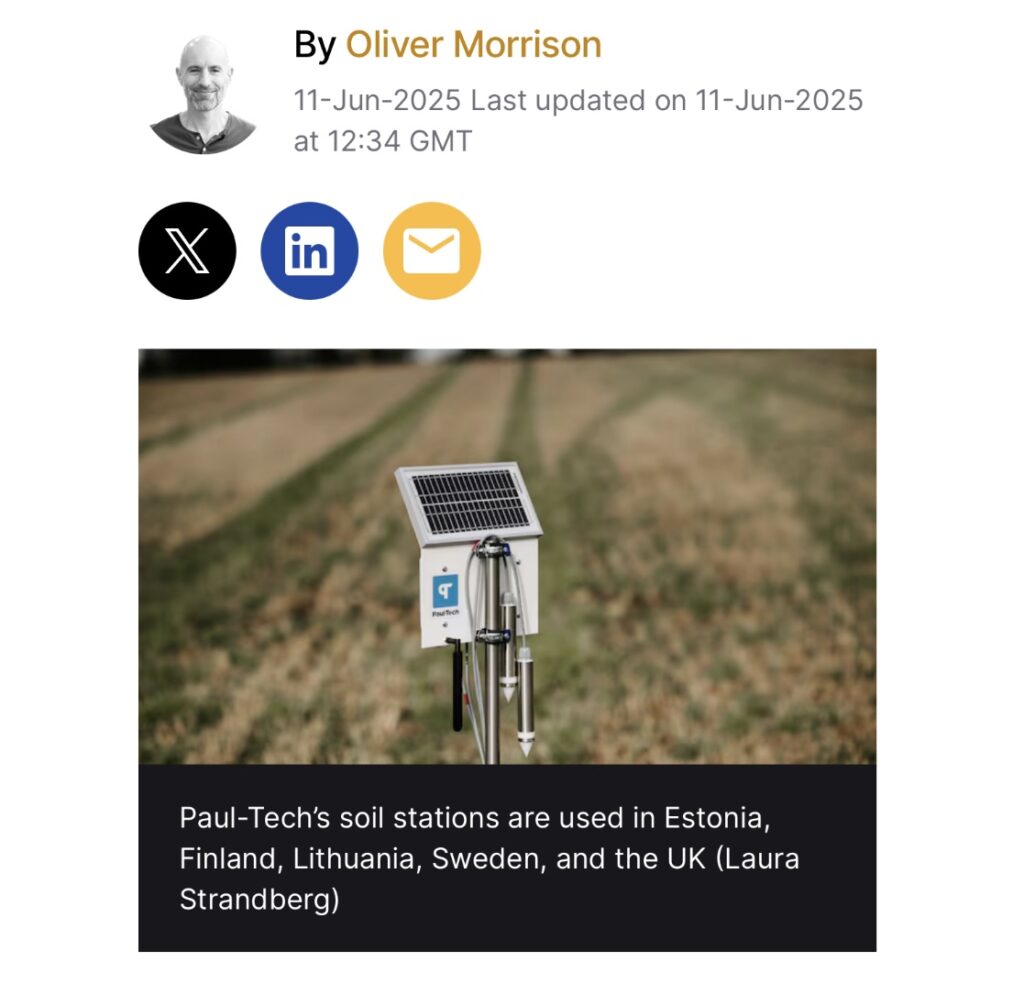
Estonian-based precision ag expert Paul-Tech has updated its soil station – which monitors nutrient movement through the soil – to measure nitrogen availability in real time. It claims the development is the first time this data is available to farmers through a reliable and proven nutrient-monitoring system. Its chief executive, Mikk Plakk, explains why.
Paul-Tech’s soil station provides per-hectare readings, showing not just total nitrogen but specifically the portion accessible to plants at any given time. The technology continuously monitors nutrient movement and nitrogen availability, integrating the data into a dashboard.
This allows farmers to make informed decisions about fertiliser application, timing, and efficiency, while also alerting them to issues like excessive leaching due to weather events.
Several companies provide solutions for monitoring soil nitrogen levels, including real-time and laboratory-based options.
According to Paul-Tech’s chief executive, Mikk Plakk, while other sensor technologies — such as multispectral cameras and ion-selective electrodes – have attempted to measure nitrate nitrogen in situ, none have achieved ‘reliable, continuous monitoring’ in real-world farm conditions.
“None of these solutions have proven reliable in real agricultural soils – they require frequent recalibration or only function within a very narrow moisture range,” he said.
“However, we can now collect this data and incorporate it into the graph view within our system. As a result, it provides vital insights into the precise nitrogen requirements of crops and can drive significant efficiencies within a farm business.”
Why is real-time nitrate nitrogen availability in demand?
He told AgTechNavigator why real-time nitrate nitrogen availability is so significant. “Because NO₃-N is the most used nutrient in the industry, which also causes a lot of environmental issues when excessively used, the market is looking for these types of sensors for nitrate monitoring to maximise the usage of nitrogen so all of it will be used by the crops for yield enhancement instead of just wasting it blindly.”
Paul-Tech has found a way to assess the available nitrates from our existing data based on multiple electrical parameters, he told us. “Our technology itself is proven and reliable, with over 13 million measurements taken from real-life field conditions. That is why we claim that we are the only proven real-time nitrate sensor on the market currently.”
Accurate and actionable
Paul-Tech’s system can identify early indicators of crop stress, such as nutrient deficiencies or water stress, allowing for timely interventions that prevent yield losses. The data is highly accurate and actionable, integrating real-time soil measurements with weather forecasts and satellite imagery, Plakk added. This comprehensive approach allows for precise, crop-specific recommendations, enhancing decision-making for fertilisation, irrigation, and other agronomic practices.
“Paul-Tech provides individualised, crop-specific, time-of-year-specific, etc., easy-to-understand interpretations of the data we collect. This is the basis of making it more actionable for farmers. We are taking away the need for analysis of data.”
Paul-Tech’s system combines real-time soil data with weather forecasts and satellite imagery, providing a holistic view of field conditions which are analysed and presented as “easy-to-understand one-liners”, he said. “We can integrate with other systems via our API. This integration facilitates informed decision-making across various aspects of farm management,” he said.
“Installation is straightforward, with sensors placed at specific soil depths based on crop needs. The stations are autonomous, solar-powered, and require minimal maintenance, operating without the need for external power sources or internet connectivity.”
What are the results?
On average, the company is seeing results of a 20% reduction in nitrogen usage while maintaining the yield at the current year’s potential, he claimed. “There have been even reductions up to 70% while maintaining the yield at last year’s level,” he said.
“In addition, farmers are making changes to their planned spraying rounds by altering mixtures that they are using in relation to available soil water and possible drought stress, or the field being at field capacity.”
According to Eve Plakk, Paul-Tech’s product manager and co-founder, the latest development was a direct result of feedback from Paul-Tech’s clients.
She said: “One of the most frequently asked questions from our clients has been whether it’s possible to see nitrogen quantities in kilograms per hectare. “We’ve now reached a point in product development where we can show this – and not just total nitrogen, but the portion that is actually accessible to plants.
“This has generated great excitement among both current and potential customers. It’s a major step toward ensuring every fertilisation decision is informed and justified.”